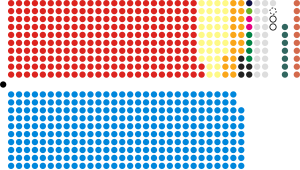House of Commons Table Office
| House of Commons of the United Kingdom of Great Britain and Northern Ireland | |
|---|---|
| Type | |
| Type | |
| Leadership | |
|
John Bercow MP
Since 22 June 2009 |
|
| Structure | |
| Seats | 650 |
 |
|
|
Political groups
|
|
|
Length of term
|
up to 5 years |
| Elections | |
| First-past-the-post | |
|
Last election
|
8 June 2017 |
|
Next election
|
Latest, 5 May 2022 |
| Redistricting | Boundary commissions |
| Meeting place | |
 |
|
| House of Commons chamber Palace of Westminster City of Westminster London, United Kingdom |
|
| Website | |
| parliament.uk | |
The House of Commons is the lower house of the Parliament of the United Kingdom. Like the upper house, the House of Lords, it meets in the Palace of Westminster. Officially, the full name of the house is: the Honourable the Commons of the United Kingdom of Great Britain and Northern Ireland in Parliament assembled.
The Commons is an elected body consisting of 650 members known as Members of Parliament (MPs). Members are elected to represent constituencies by first-past-the-post and hold their seats until Parliament is dissolved.
The House of Commons of England evolved in the 13th and 14th centuries. It eventually became the House of Commons of Great Britain after the political union with Scotland in 1707, and assumed the title of "House of Commons of Great Britain and Ireland" after the political union with Ireland at the start of the 19th century. The "United Kingdom" referred to was the United Kingdom of Great Britain and Ireland from 1800, and became the United Kingdom of Great Britain and Northern Ireland after the independence of the Irish Free State in 1922. Accordingly, the House of Commons assumed its current title.
Under the Parliament Act 1911, the Lords' power to reject legislation was reduced to a delaying power. The Government is solely responsible to the House of Commons and the Prime Minister stays in office only as long as he or she retains the support of a majority of the Commons.
...
Wikipedia
